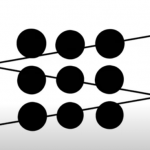Dot to dots
 10 min |
Individual |
Game
Creativity Value creation
10 min |
Individual |
Game
Creativity Value creation
What can students learn from this?
Usually when trying to answer this quiz, the first attempt is with drawing a line that goes beyond the limitations of the imagined box. This is where the cliché “Think out of the box” comes from.
To solve it, students have to start the line outside of the imaginary box. Or, in other words, they have to break normal thinking patterns.
How can I do this in class?
Step 1: Provide all students one paper with the Nine Dots image each and one pen
Step 2: Give the students with precise instructions:
They have 5 minutes to connect all nine dots in the image with no more than four straight lines, without lifting the hand from the paper and without retracing the path.
Step 3: After 5 minutes check the results.
Step 4: Ask the students to answer these two questions by raising up their hands:
-How many students were able to solve the puzzle with four straight lines?
-How many students did not solve the puzzle and were stuck in the arrangement of the dots as a box or square.
Step 5: Solve the puzzle on a white board. Start from the most common mistakes as shown below:
-The square path: 
-The criss-cross path: 
-The zig-zag path: 
-The path starting from the middle: 
-The triangle(s) path: 

Step 6: Add a square line around the nine dots and ask your students to solve it with this additional constraint: keep the four lines inside the box. See the image below:

Solution: 
Reflection tips
– Once perceived as a box, most people will not exceed the imaginary boundaries of the imaginary box and are unable to solve the puzzle. Even if there is nothing in the challenge statement that defines the arrangement as a box and nothing demands the lines must be drawn within the box, but people make the assumption based on past experiences with boxes and find the puzzle difficult.
– The reason to add a square around the dots is to provide a different “frame of reference” if they are not able to do it by themselves. In this case, the students must also consider the space inside the box as eligible. This demonstrates you should not tell the students to “think outside the box” rather to “draw them a bigger box”.
– Before working on the solutions with the class, give them the possibility to try it again using no more than five straight lines or retrace the steps.
– After your students achieve the solution showed above, you can make the challenge more difficult by asking them to solve the puzzle with three straight lines
Three lines solution: 
Relevant useful material

Video
![]() 10 min |
Individual |
Game
10 min |
Individual |
Game












